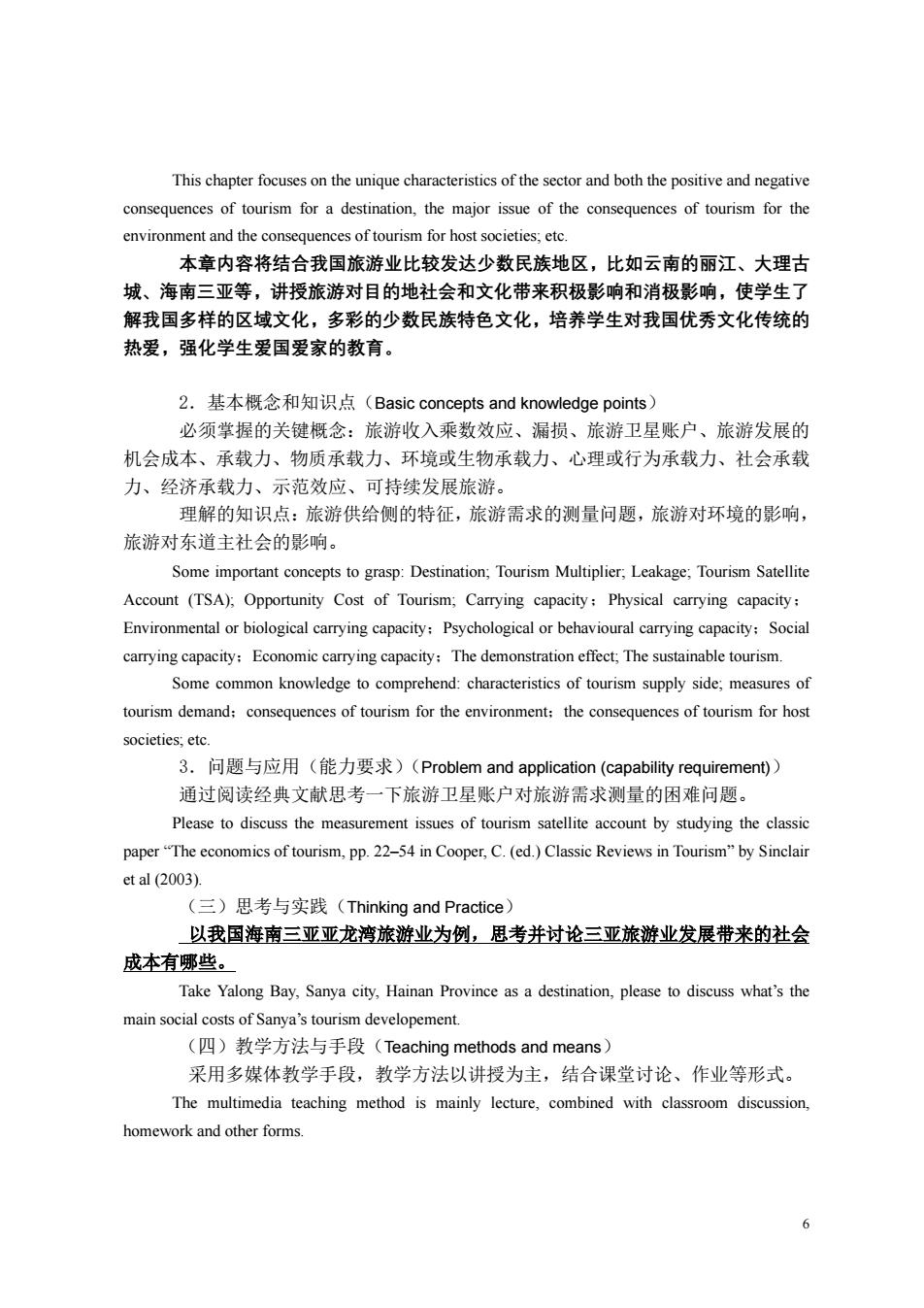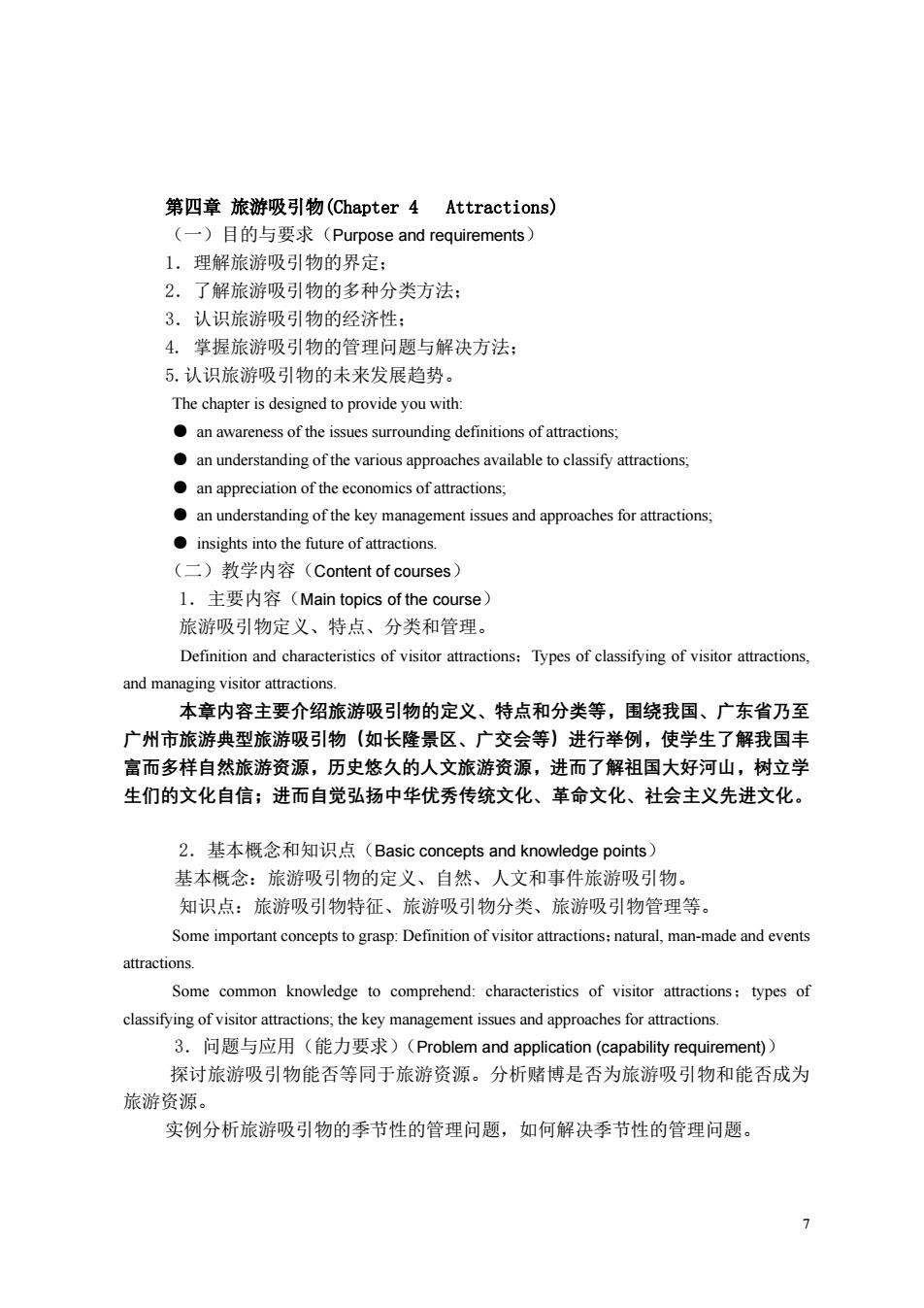
This chapter focuses on the unique characteristics of the sector and both the positive and negative consequences of tourism for a destination,the major issue of the consequences of tourism for the environment and the consequences of tourism for host societies:etc. 本章内容将结合我国旅游业比较发达少数民族地区,比如云南的丽江、大理古 城、海南三亚等,讲授旅游对目的地社会和文化带来积极影响和消极影响,使学生了 解我国多样的区域文化,多彩的少数民族特色文化,培养学生对我国优秀文化传统的 热爱,强化学生爱国爱家的教育。 2.基本概念和知识点(Basic concepts and knowledge points) 必须掌握的关键概念:旅游收入乘数效应、漏损、旅游卫星账户、旅游发展的 机会成本、承载力、物质承载力、环境或生物承载力、心理或行为承载力、社会承载 力、经济承载力、示范效应、可持续发展旅游。 理解的知识点:旅游供给侧的特征,旅游需求的测量问题,旅游对环境的影响, 旅游对东道主社会的影响。 Some important concepts to grasp:Destination.Tourism Multiplier,Leakage:Tourism Satellite Account (TSA);Opportunity Cost of Tourism:Carrying capacity:Physical carrying capacity: Environmental or biological carrying capacity:Psychological or behavioural carrying capacity:Social carrying capacity:Economic carrying capacity:The demonstration effect The sustainable tourism. Some common knowledge to comprehend:characteristics of tourism supply side,measures of tourism demand:consequences of tourism for the environment:the consequences of tourism for host societies,etc. 3.问题与应用(能力要求)(Problem and application(capability requirement))) 通过阅读经典文献思考一下旅游卫星账户对旅游需求测量的困难问题。 Please to discuss the measurement issues of tourism satellite account by studying the classic paper"The economics of tourism,pp.22-54 in Cooper,C.(ed.)Classic Reviews in Tourism"by Sinclair etal(2003) (三)思考与实践(Thinking and Practice) 以我国海南三亚亚龙湾旅游业为例,思考并讨论三亚旅游业发展带来的社会 成本有哪些。 Take Yalong Bay,Sanya city,Hainan Province as a destination,please to discuss what's the main social costs of Sanya's tourism developement. (四)教学方法与手段(Teaching methods and means) 采用多媒体教学手段,教学方法以讲授为主,结合课堂讨论、作业等形式。 The multimedia teaching method is mainly lecture,combined with classroom discussion homework and other forms
6 This chapter focuses on the unique characteristics of the sector and both the positive and negative consequences of tourism for a destination, the major issue of the consequences of tourism for the environment and the consequences of tourism for host societies; etc. 本章内容将结合我国旅游业比较发达少数民族地区,比如云南的丽江、大理古 城、海南三亚等,讲授旅游对目的地社会和文化带来积极影响和消极影响,使学生了 解我国多样的区域文化,多彩的少数民族特色文化,培养学生对我国优秀文化传统的 热爱,强化学生爱国爱家的教育。 2.基本概念和知识点(Basic concepts and knowledge points) 必须掌握的关键概念:旅游收入乘数效应、漏损、旅游卫星账户、旅游发展的 机会成本、承载力、物质承载力、环境或生物承载力、心理或行为承载力、社会承载 力、经济承载力、示范效应、可持续发展旅游。 理解的知识点:旅游供给侧的特征,旅游需求的测量问题,旅游对环境的影响, 旅游对东道主社会的影响。 Some important concepts to grasp: Destination; Tourism Multiplier; Leakage; Tourism Satellite Account (TSA); Opportunity Cost of Tourism; Carrying capacity;Physical carrying capacity; Environmental or biological carrying capacity;Psychological or behavioural carrying capacity;Social carrying capacity;Economic carrying capacity;The demonstration effect; The sustainable tourism. Some common knowledge to comprehend: characteristics of tourism supply side; measures of tourism demand;consequences of tourism for the environment;the consequences of tourism for host societies; etc. 3.问题与应用(能力要求)(Problem and application (capability requirement)) 通过阅读经典文献思考一下旅游卫星账户对旅游需求测量的困难问题。 Please to discuss the measurement issues of tourism satellite account by studying the classic paper “The economics of tourism, pp. 22–54 in Cooper, C. (ed.) Classic Reviews in Tourism” by Sinclair et al (2003). (三)思考与实践(Thinking and Practice) 以我国海南三亚亚龙湾旅游业为例,思考并讨论三亚旅游业发展带来的社会 成本有哪些。 Take Yalong Bay, Sanya city, Hainan Province as a destination, please to discuss what’s the main social costs of Sanya’s tourism developement. (四)教学方法与手段(Teaching methods and means) 采用多媒体教学手段,教学方法以讲授为主,结合课堂讨论、作业等形式。 The multimedia teaching method is mainly lecture, combined with classroom discussion, homework and other forms

第四章旅游吸引物(Chapter4 Attractions) (一)目的与要求(Purpose and requirements) 1.理解旅游吸引物的界定: 2.了解旅游吸引物的多种分类方法: 3.认识旅游吸引物的经济性: 4.掌握旅游吸引物的管理问题与解决方法: 5.认识旅游吸引物的未来发展趋势。 The chapter is designed to provide you with: an awareness of the issues surrounding definitions of attractions; an understandingof the various approaches available to. an appreciation of the economics of attractions, an understanding of the key management issues and approaches for attractions insights into the future of attractions. (二)教学内容(Content of courses I.主要内容(Main topics of the course) 旅游吸引物定义、特点、分类和管理 Definition and characteristics of visitor attractions:Types of classifying of visitor attractions. and managing visitor attractions 本章内容主要介绍旅游吸引物的定义、特点和分类等,围绕我国、广东省乃至 广州市旅游典型旅游吸引物(如长隆景区、广交会等)进行举例,使学生了解我国丰 富而多样自然旅游资源,历史悠久的人文旅游资源,进而了解祖国大好河山,树立学 生们的文化自信;进而自觉弘扬中华优秀传统文化、革命文化、社会主义先进文化, 2.基本概念和知识点(Basic concepts and knowledge points) 基本概念:旅游吸引物的定义、自然、人文和事件旅游吸引物。 知识点:旅游吸引物特征、旅游吸引物分类、旅游吸引物管理等 Some important concepts to grasp:Definition of visitor attractions:natural,man-made and events attractions. Some common knowledge to comprehend:characteristics of visitor attractions:types of classifying of visitor attractions,the key management issues and approaches for attractions. 3.问题与应用(能力要求)(Problem and application(capability requirement)) 探讨旅游吸引物能否等同于旅游资源。分析赌博是否为旅游吸引物和能否成为 旅游资源。 实例分析旅游吸引物的季节性的管理问题,如何解决季节性的管理问题
7 第四章 旅游吸引物(Chapter 4 Attractions) (一)目的与要求(Purpose and requirements) 1.理解旅游吸引物的界定; 2.了解旅游吸引物的多种分类方法; 3.认识旅游吸引物的经济性; 4. 掌握旅游吸引物的管理问题与解决方法; 5.认识旅游吸引物的未来发展趋势。 The chapter is designed to provide you with: ● an awareness of the issues surrounding definitions of attractions; ● an understanding of the various approaches available to classify attractions; ● an appreciation of the economics of attractions; ● an understanding of the key management issues and approaches for attractions; ● insights into the future of attractions. (二)教学内容(Content of courses) 1.主要内容(Main topics of the course) 旅游吸引物定义、特点、分类和管理。 Definition and characteristics of visitor attractions;Types of classifying of visitor attractions, and managing visitor attractions. 本章内容主要介绍旅游吸引物的定义、特点和分类等,围绕我国、广东省乃至 广州市旅游典型旅游吸引物(如长隆景区、广交会等)进行举例,使学生了解我国丰 富而多样自然旅游资源,历史悠久的人文旅游资源,进而了解祖国大好河山,树立学 生们的文化自信;进而自觉弘扬中华优秀传统文化、革命文化、社会主义先进文化。 2.基本概念和知识点(Basic concepts and knowledge points) 基本概念:旅游吸引物的定义、自然、人文和事件旅游吸引物。 知识点:旅游吸引物特征、旅游吸引物分类、旅游吸引物管理等。 Some important concepts to grasp: Definition of visitor attractions;natural, man-made and events attractions. Some common knowledge to comprehend: characteristics of visitor attractions;types of classifying of visitor attractions; the key management issues and approaches for attractions. 3.问题与应用(能力要求)(Problem and application (capability requirement)) 探讨旅游吸引物能否等同于旅游资源。分析赌博是否为旅游吸引物和能否成为 旅游资源。 实例分析旅游吸引物的季节性的管理问题,如何解决季节性的管理问题